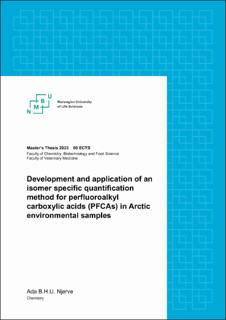| dc.description.abstract | Per- and polyfluoroalkyl substances (PFAS) are anthropogenic, persistent pollutants found all over the world. These compounds have the ability to repel both water and oil, and are known for their durability. Since the 1950s perfluoroalkyl carboxylic acids (PFCAs), a group of PFAS, have been used in various industries as e.g., surfactant materials and firefighting foam. PFAS have been found in the environment, both locally and remotely from where they were disposed. These fluorinated substances are known to pose health risks to humans and animals all around the world and are therefore crucial to investigate.
In this project, a HPLC-MS/MS method was developed and validated for isomeric analysis of twelve PFCAs, including linear perfluorooctanoic acid (L-PFOA). To gain a better understanding of the consequences of PFAS abundance in the Arctic, water and soil samples were collected from Ny-Ålesund, Svalbard. The water (n=4) and soil (n=2) samples were collected in June of 2016 close to a fire-fighting training site (FFTS), where PFAS containing firefighting foam had previously been used over 10 years ago. Additional water samples (n=3) were collected from meltwater away from the FFTS. The water samples closest to the FFTS had a mean concentration of target analytes at 40-56 ng/mL, while the soil samples measured between 11-24 ng/mL. The remaining water samples had concentrations of 0.6-14 ng/mL.
Because the electrochemical fluorination process of producing PFAS gives a composition of <80% linear and >20% branched PFAS, it was investigated to gain a further understanding of the source of contamination in Ny-Ålesund. Contrary to firefighting foam, this process was never executed on Svalbard. The water samples close to the FFTS had compositions of L-PFOA at 87-94%, showing local contamination. The soil samples had 91-95% L-PFOA, which also suggests local contamination. The other water samples were at 0-87% L-PFOA, along with other parameters, can suggest remote contamination. Such discoveries can signify source of contamination, as well as giving a greater understanding of the target analytes’ abundance in the Arctic. | |
